The Springbok Tour
A DigitalNZ Story by Hana McIntyre
A digitalNZ story by Hana McIntyre
The springbok tour of the 1980’s was the largest civil disturbance New Zealand had seen in thirty years. The whole of New Zealand was divided over the tour, this division of the country lasted over fifty days. The Springbok tour was a real factor in the way New Zealand grew as a county. The outcomes that arose from the tour has led New Zealand to find and express our identity as people and as nation.

Maori take a stand
A group of maori protesters stand together with helmets on as police with baton smarch behind them.
Museum of New Zealand Te Papa Tongarewa
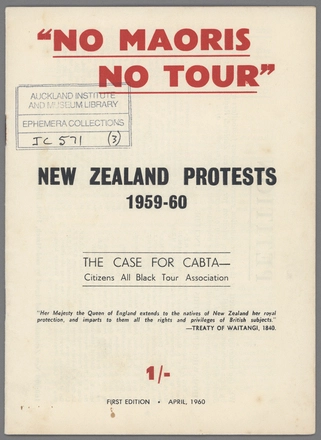
The beginning
This pamphlet was given out in the 1960's in an effort to have maori included in the tour.
Auckland War Memorial Museum Tāmaki Paenga Hira
Together as a nation
All people of NZ came together to protest the tour, despite the debate on NZ racism, people of all backgrounds joined.
The tour was a useful tool as it helped to kick start the discussion of New Zealand's identity. For many decades New Zealand was in a limbo, we had the fundamentals of a culture events, people and objects all people could relate to. This is prominent in the source of the tour, rugby. Such a staple in ‘kiwi culture’, rugby is a thing everybody could enjoy no matter their race, age or gender. Rugby was a nationwide spot that the rest of the world knew as kiwi culture. However, this all changed when the announcement was made that the All Black would be taking am ‘all white’ team to play the springbok tour in South Africa.
Police resistance
Police and protesters in 1981
Children joined the fight
The tour did not only see adults who fought and protested, but it also saw young children protesting with their familie.
NZ Police 1981
Police where given 'night sticks' to keep protesters under control.
A nation always slightly confused about where the line of culture stood between Maori natives and the pakeha. This was an event that would change the way Maori people saw themselves and their culture within New Zealand's culture. People started to stand against the tour, peaceful marches where organized, rallies with children were held. People even boycotted games in an effort to bring awareness to the fact that an ‘all white’ team was unacceptable in a country where its native people would not be included in such a prominent activity that defined the nations sporting culture.
The riot squad posing for a picture in 1981. They where a step up for NZ police and a shock for NZ people.
Peaceful protesters fight against the Springbok tour and for the recognition of NZ's own faults.
The uncle of the of the captain of the NZ Maori team stood with the NZ Police in napier in 1981
Alexander Turnbull Library
Maori and Pacifica people started to express their identities more, “people started to realize you can’t protest against racism 6,000 miles away when it’s right here in your country” - John Minto This quote from John Minto clearly sums up the thoughts of many people at the time. How are we as a country supposed to find a collective identity if we cannot even see the own blatant racism that happens daily in New Zealand.
The New Zealand Police force are not known to be aggressive or violent. However, the springbok tour bought out the worst in the Police of New Zealand. On the night of the 21st of July 1981 Police brought down their ‘nightsticks’ onto a crowd protester’s who refused to ‘halt’, leaving many people with injuries. This is a prominent event within the Springbok tour. However, New Zealand does not let this define our police nor do we let it impact our culture in a manner where we lost all of the good relations between police and the New Zealand public. This however did tend to complicate the traditional depictions of kiwi culture, as we now had to reinvent the culture of NZ Police.
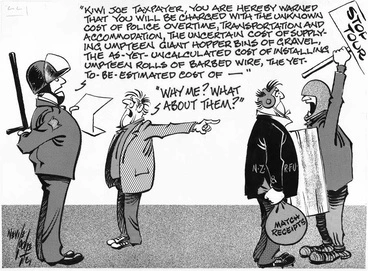
Public opinions
The tour effected everyone, the people who had a voice in society often used it in many ways this time a comic was drawn
Manatū Taonga, the Ministry for Culture and Heritage
![[Springbok Tour - Auckland street protest] Image: [Springbok Tour - Auckland street protest]](https://thumbnailer.digitalnz.org/?resize=770x&src=https%3A%2F%2Fmedia.api.aucklandmuseum.com%2Fid%2Fmedia%2Fp%2Fd3085a739ec91232075a008722345e591fec81aa%3Frendering%3Dstandard.jpg&resize=368%253E)
Police vs Civilians
The tour of 1981 hindered civilians relations with NZ Police.
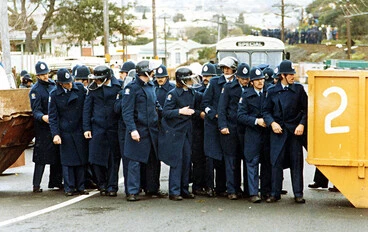
Police force
Police men and women get ready to face another encounter with protesters.
The tour tells us many things about how kiwis expressed their identities in the past. New Zealand has never been a violent country, new Zealanders have tended to express and convey their feeling through actions and speech. This is a part of kiwi identity in itself, we don’t identify as aggressive people or a nation who is an aggressive world party. This alone reinforces the idea of traditional ‘Kiwi Culture’. We are known as a people of fierce warriors but also known as a nation of respect and understanding.
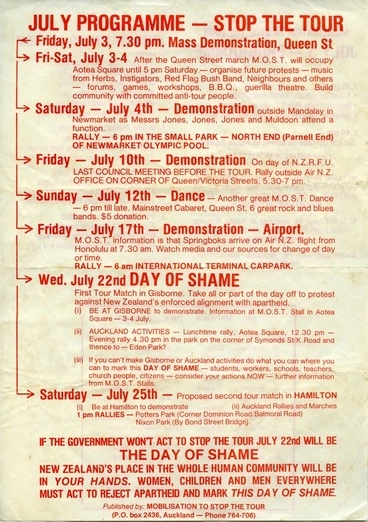
Springbok Tour protest programme
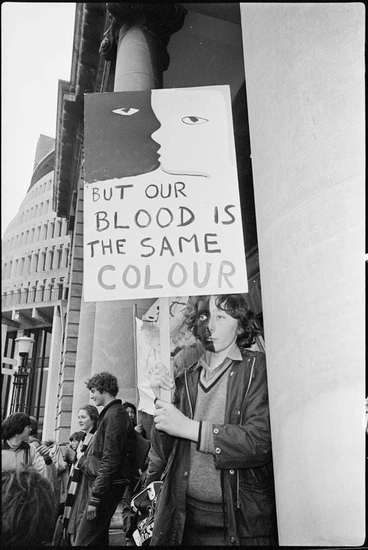
School children protesting, 1981 Springbok tour
Furthermore, this event deepened our Maori populations identity within New Zealand. The tour made many people realize how poorly our own native people has been treated within our society. This was a catalyst for the change that we see today. Over the past thirty years New Zealand’s identity has become much more inclusive of Maori and all their traditional customs. Maori have become a large part of Kiwi identity and a larger part of ‘kiwi culture’. While the tour was a confusing time for many New Zealanders its consequence of the highlighting of Maori injustice helped to confirm what we see now as ‘traditional kiwi culture’.
New Zealand has always been a proud country, we like to think that we have always had each other's backs and continue to do so even through the toughest of times. The springbok tour was a major exception to this belief. However, this tour ended up adding value and lessons to which became some of New Zealand's most important values and morals. These have now become what we call ‘Kiwi culture’.
Peaceful Protest 1981
The people of New Zealand banded together for peaceful protests against the tour in Wellington 1981
Bibliography
References:
M. (2014, August 5). 1981 Springbok tour. Retrieved from https://nzhistory.govt.nz/culture/1981-springbok-tour
T. (2006, July 16). Springbok Tour Protests 'Good For Maori'. Retrieved from http://www.scoop.co.nz/stories/PO0607/S00145.htm
M. (2018, July 20). Police baton anti-tour protesters outside Parliament. Retrieved from https://nzhistory.govt.nz/police-baton-anti-springbok-tour-protestors-near-parliamentv
Listener, T. (2016, November 21). Inside the 1981 Springbok tour. Retrieved from https://www.noted.co.nz/archive/listener-nz-2011/inside-the-1981-springbok-tour/
Wellington City Libraries. (n.d.). Retrieved from http://www.wcl.govt.nz/heritage/tour.html
Roughan, J. (2017, August 25). NZ memories: Protests during the Springboks tour. Retrieved from https://www.nzherald.co.nz/nz/news/article.cfm?c_id=1&objectid=10830511
http://www.aucklandmuseum.com/collection/object/am_library-ephemera-11756
https://natlib.govt.nz/records/22905580?search%5Bi%5D%5Bcollection%5D=Dominion+post+%28Newspaper%29%3A+Photographic+negatives+and+prints+of+the+Evening+Post+and+Dominion+newspapers&search%5Bi%5D%5Bprimary_collection%5D=TAPUHI&search%5Bi%5D%5Bsubject%5D=Police&search%5Bpath%5D=items
- Home Kāinga
- Our Story Ngā Kōrero
- Our Tours Ngā Haerenga
- Wellington Museum Te Waka Huia o Ngā Taonga Tuku Iho
- Space Place Te Ara Whānui ki te Rangi
- Nairn Street Cottage
- Cable Car Museum
- Careers Umanga
- What’s On Ngā Kaupapa Whakatairanga
- Museum Blog
- Our Venues Ngā Wāhi
- Venues at Wellington Museum Ngā Wāhi i Te Waka Huia o Ngā Taonga Tuku Iho
- Venues at Space Place Ngā Wāhi i Te Ara Whānui ki te Rangi
- Birthday Parties Ngā Pāti Rā Whānau
- Recommended Caterers Ētahi Kaitaka Kai
- Education Blog Rangitaki Mātauranga
- Space Place
- Wellington Museum
- Space Place Wāhi Haumaru
- Venues at Space Place Ngā Wāhi i Te Wāhi Haumaru
- Support Us Tautoko
- Museum Blog Te Kāpata Te Curio
Remembering the 81′ Springbok Tour
40 years on, we look back and talk to two Wellington residents who remember those turbulent times.
“All for the sake of a Rugby game. Doesn’t make sense does it?” – Liz Roberts
During the winter of 1981, violent clashes between rugby supporters, protesters and the police erupted all over Aotearoa in one of our country’s most tumultuous periods. The Springbok rugby tour brought us to the brink of civil war, as many protested the racial segregation of Apartheid South Africa and made links to racism at home.
On the 29th of July, 1981, protesters opposing the Springbok Tour were met by baton-wielding police trying to stop them marching up Molesworth St to the home of South Africa’s Consul to New Zealand.
This was the first time police had used batons against protestors, and the violence horrified many New Zealanders. Former Prime Minister Norman Kirk’s prediction eight years earlier that a tour would result in the ‘greatest eruption of violence this country has ever known’ seemed to ring true.
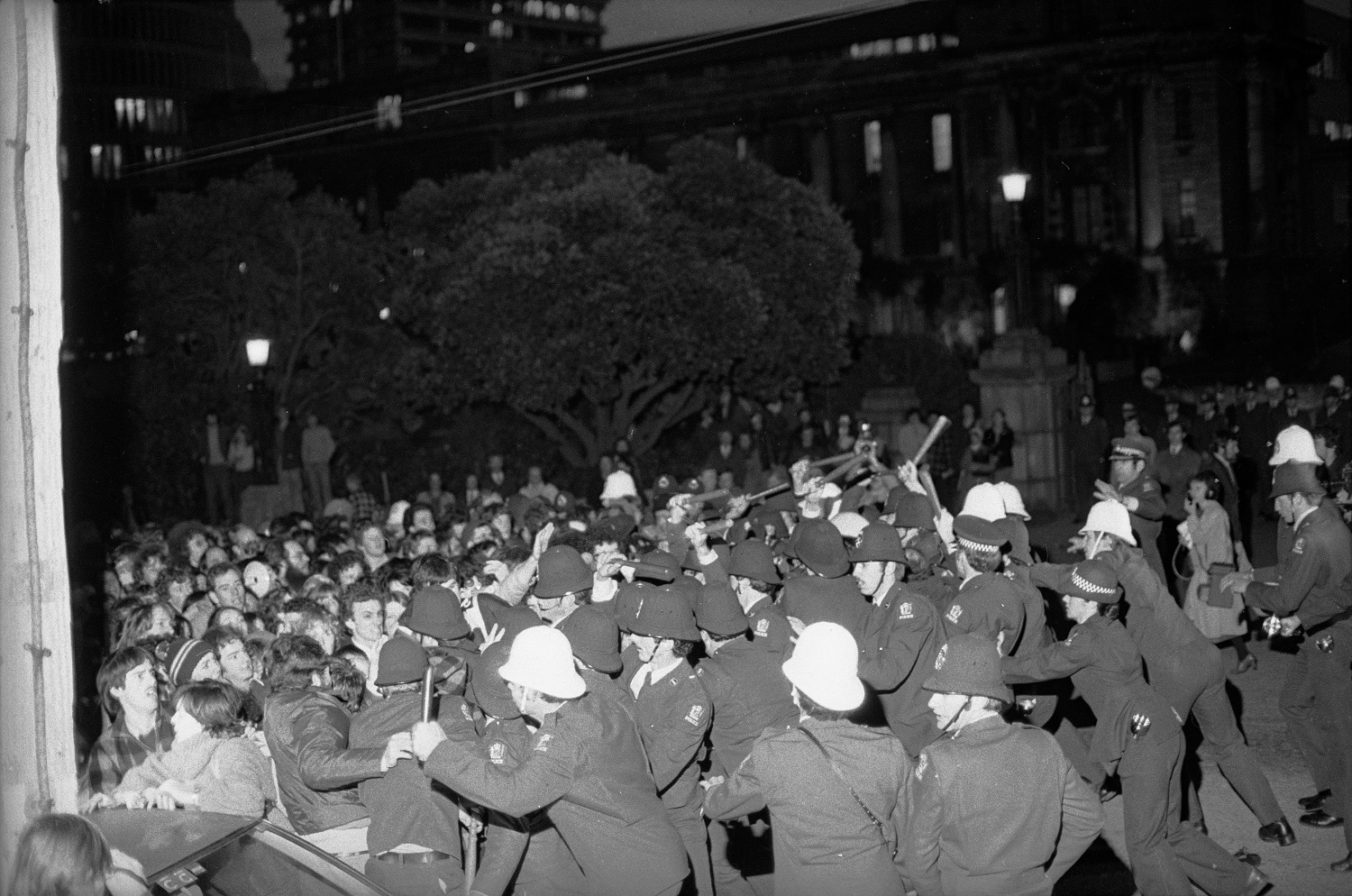
Wearing helmets like this one, 7000 protesters gathered in central Wellington and around Athletic Park on 29th of August 1981 to stop pro-tour supporters from gaining access to the second test match. Once again the police intervened, this time using long batons, with many protesters injured as a result. This helmet was worn by Anne Bogle during other anti-tour protests.
The Merata Mita Estate permitted us to use the Wellington footage from PATU! (1983) – the powerful documentary directed by Merata Mita which shows the harrowing events of the 1981 Springbok Tour.
Ngā Taonga Sound and Vision meticulously restored and preserved the original documentary for the 40th anniversary. With their approval, we were able to use their newly restored and remastered version for these videos.
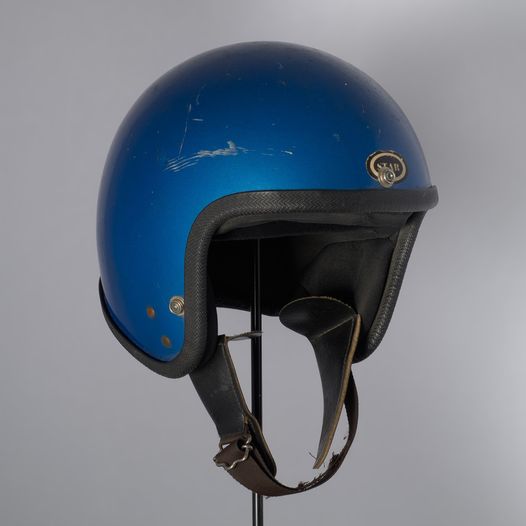
Liz Roberts lived on Te Wharepōuri Street in Berhampore, close to Athletic Park, and recalls the events of the 2nd Test on August 29th, 1981, where she saw protesters clash with Police on her street.
Anne Bogle was a young Victoria University student studying Law and History in 1981 – and attended a number of Anti-Tour protests in Wellington – she took part in the protest group that blocked the Wellington Motorway on July 25th and the infamous Molesworth Street incident a few days later on July 29th. The protester helmet she used during the anti-tour demonstrations is currently displayed at Wellington Museum.
Thank you to the Merata Mita Estate for their permission to use parts of the film and also to Ngā Taonga Sound and Vision for their great mahi on the preservation and restoration of this important piece of film taonga .
Also thank you to Anne Bogle and Liz Roberts for sharing their stories.
Pin It on Pinterest

Remembering the 1981 Springboks Tour
For the 40th anniversary of the 1981 Springbok Tour, we talked to two Wellington residents who remember those turbulent times.
During the winter of 1981, violent clashes between rugby supporters, protesters and the police erupted all over Aotearoa in one of our country’s most tumultuous periods. The Springbok rugby tour was a tumultuous time for the nation with many protesting the racial segregation of Apartheid South Africa and made links to racism at home.
Our Digital Communicator, Tom Etuata and our Senior Curator (Taonga Māori), Lawrence Wharerau, interviewed Liz Roberts and Anne Bogle, who both shared their stories of the protests.
The Merata Mita Estate permitted us to use the Wellington footage from PATU! (1983) – the powerful documentary directed by Merata Mita which shows the harrowing events of the 1981 Springbok Tour. Ngā Taonga Sound and Vision meticulously restored and preserved the original documentary for the 40th anniversary. With their approval, we were able to use their newly restored and remastered version for these videos.
Liz Roberts lived on Te Wharepōuri Street in Berhampore, close to Athletic Park, and recalls the events of the 2nd Test on August 29th, 1981, where she saw protesters clash with Police on her street.
Anne Bogle was a young Victoria University student studying Law and History in 1981 – and attended a number of Anti-Tour protests in Wellington – she took part in the protest group that blocked the Wellington Motorway on July 25th and the infamous Molesworth Street incident a few days later on July 29th. The protester helmet she used during the anti-tour demonstrations is currently displayed at Wellington Museum.
Thank you to the Merata Mita Estate for their permission to use parts of the film and also to Ngā Taonga Sound and Vision for their great mahi on the preservation and restoration of this important piece of film taonga.
Also thank you to Anne Bogle and Liz Roberts for sharing their stories.
Share this:
- Click to share on Twitter (Opens in new window)
- Click to share on Facebook (Opens in new window)
Recent Posts
- Mātanga Pakihi | Retail Specialist Wellington Museum
- Kaiārahi Wheako Manuhiri | Manager Visitor Experience
- Kaitohutohu Wheako Manuhiri | Visitor Experience Advisor
- 14 Unique Things to Do in Wellington
- Wellington Museum continues to welcome visitors after seismic assessment
Recent Comments
- October 2023
- February 2023
- October 2022
- November 2021
- October 2021
- September 2021
- August 2020
- August 2018
- October 2017
- October 2016
- September 2016
- Job Vacancy
- Uncategorized
- Entries feed
- Comments feed
- WordPress.org
- Explore Tūhura
- Collections Ngā Kohinga
- Interviews Ngā Uiuinga
- Profiles Ngā Tāngata
- Watch list Rārangi Mātakitaki
The Springbok Tour - 35 Years On
Tuesday 19 July marks the 35th anniversary of the Springboks' arrival in New Zealand for the 1981 rugby tour. Collected below are classic documentaries on the tour and subsequent mass protests ( Patu! , Try Revolution ), anti-tour protest songs, and a doco on the All Blacks’ first post-apartheid tour of South Africa. There's also an excerpt from Tom Scott's 2011 Springbok tour drama Rage .
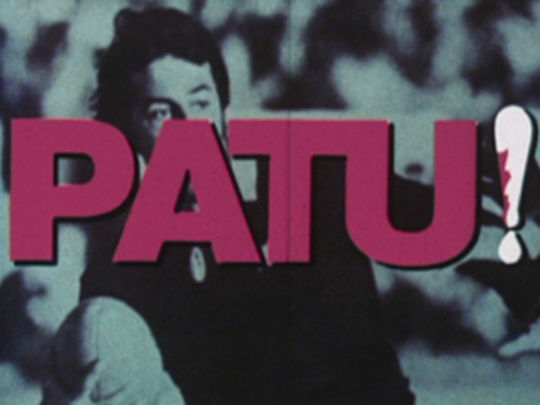
Film, 1983 (Documentary, NZ History)
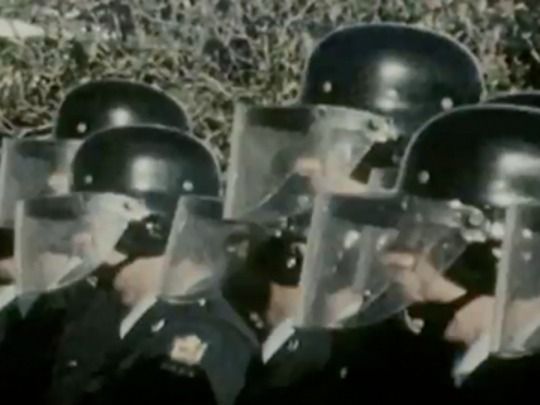
Try Revolution
Television, 2006 (Documentary, NZ History)
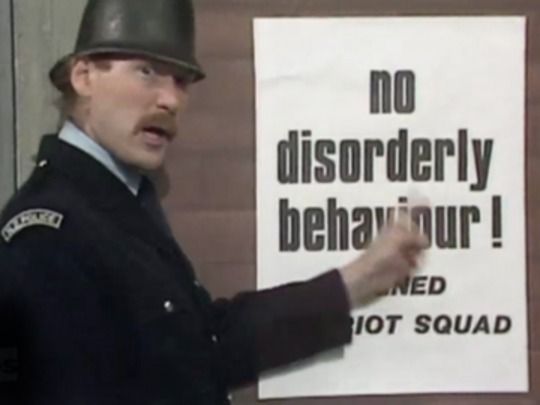
Music Video, 1981 (Rock, Soul)
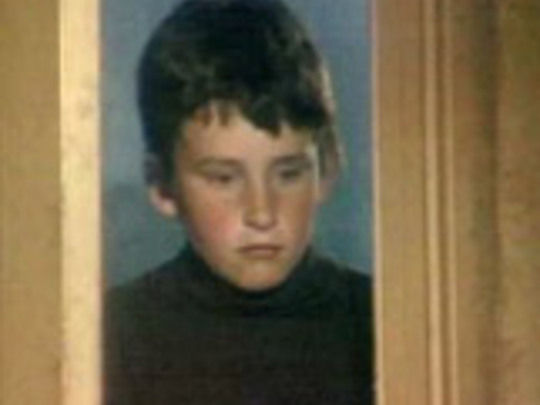
The Garlick Thrust
Television, 1983 (NZ History, Drama)
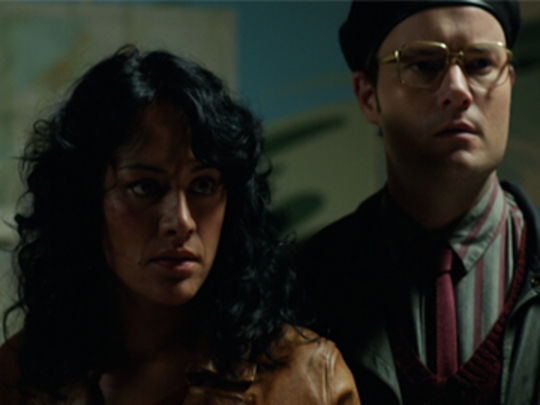
Television, 2011 (NZ History, Drama)
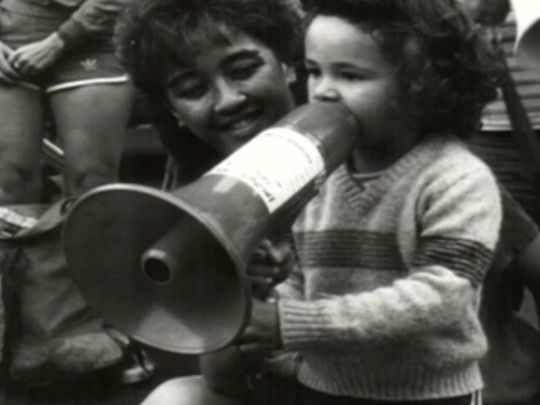
Children of the Revolution
Television, 2007 (Documentary, NZ History)
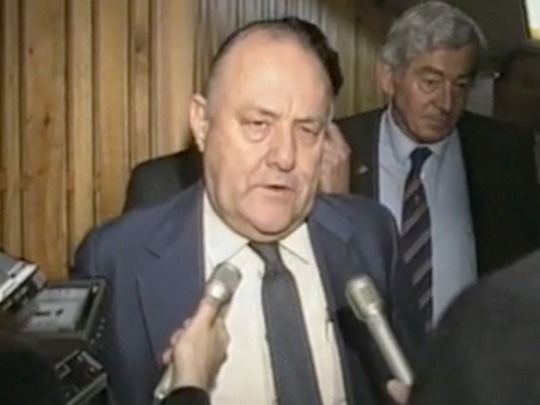
Revolution - 1, Fortress New Zealand
Television, 1996 (Documentary, NZ History)
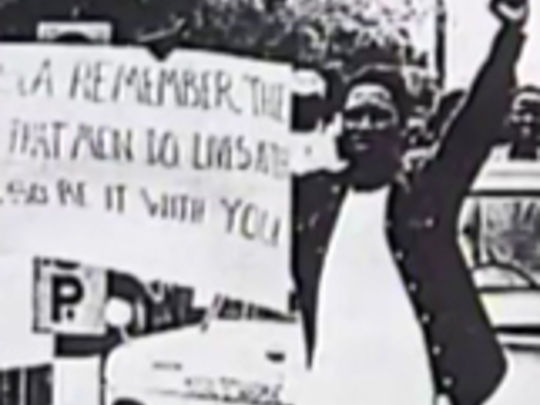
Music Video, 1981 (Reggae)
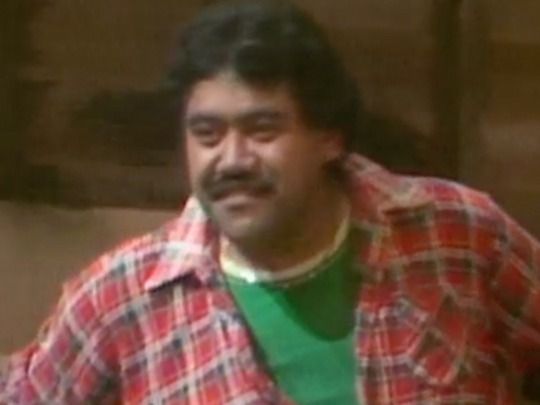
Loose Enz - The Protesters
Television, 1982 (Drama, Māori)
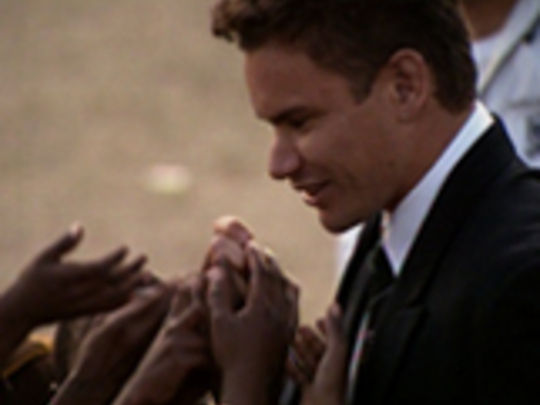
All Blacks for Africa - A Black and White Issue
Television, 1992 (Sport, Documentary, NZ History)
Don't have an account? Create an account here
- Access Statement
- Community Archive
- Family History
Sir Michael Fowler
- Molesworth Street
- Related Items (9)
- Related Items (5)
- Related Items

- Property Search
- Archives online user guide

"I hope that common sense will prevail." – Sir Michael Fowler, Mayor of Wellington, 28th August 1981 From 22 July – 12 September 1981 the South African Rugby Union team (known as the Springboks) toured New Zealand playing 14 games. Due to the South African governments policy of apartheid, the tour was marred by protests and police violence. The All Blacks and the Springboks had been fierce rivals since their first face-off at Athletic Park in 1928, and rugby had since become New Zealand’s national identity. But at the same time, South Africa’s system of racial apartheid had grown unacceptable to many people in New Zealand and overseas. Wellington was a focal point for much of the anti-tour movement during 1981 tour. The Mayor and many of the City Councillors came out against the tour, and several attempts were made by Council to prevent a test match in the City. Protesters clashed with police during a protest on Molesworth Street leaving many battered and bloody. When they next met outside Athletic Park on the day of the test, the protesters came prepared with helmets and shields. The Springboks left New Zealand following their final game in Auckland and would not return until 1994 and the dismantling of apartheid. Linked below are photos of anti-tour posters and pamphlets taken by the City Photographer, as well as a considerable amount of correspondence to and from Mayor Fowler via the Town Clerk's Department. The featured minute book contains City Council meetings related to the tour on pages 207-208 (images 286-287) and 221-222 (images 300-301).
Copy: Abortion, Apartheid, Unions, Nuclear (posters, handouts, protests)
Notice of motion: Springbok Rugby Tour, REDACTED
Volume 102, REDACTED, Minutes of meetings of the Wellington City Council 5 Jun 1981 to 11 Nov 1981
Remembering (and forgetting) the 1981 Springbok tour
10 September 2021
The narrative of the 1981 Springbok tour continues to reflect New Zealand's anti-apartheid views, but in fact protestors treated it more as a critique of New Zealand Society, research shows.
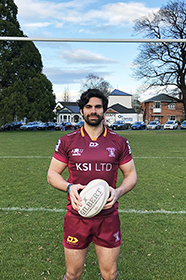
This weekend's 40th anniversary of the historic Springbok Eden Park rugby match, also marks the completion of five years of research by Dr Sebastian JS Potgieter, a teaching fellow at the School of Physical Education, Sport and Exercise Sciences , on the enduring narrative of the nation-defining tour.
Dr Potgieter, who was raised in South Africa, says the 1981 Springbok tour is primarily viewed as an anti-apartheid struggle which serves to construct New Zealand society in a favourable way.
“Apartheid was a major factor in catalysing the protests, but protestors treated it more as a critique of New Zealand society in a broader sense,” Dr Potgieter says.
“Continuing to view 1981 as primarily an anti-apartheid struggle serves to forget some of the unpalatable realities that accompanied the tour.”
It was a box of documents about the 1981 tour, stored in a farm shed in South Africa, that was the starting point of five years of postgraduate research for Dr Potgieter.
“It was only when I started going through all the documents and correspondence that it became apparent what a huge event it was on so many levels, and that in South Africa we weren't fully aware of what the tour had meant for New Zealand,” Dr Potgieter explains.
“What fascinated me were the 'aspects' of the 1981 tour which were consistently and selectively remembered, and in particular the predominant anti-racist and anti-apartheid aspects that still remain the main narrative by which the tour is remembered.”
Dr Potgieter says this narrative is a very selective understanding of the tour and conflicts with the accounts of those who had participated in the anti-tour campaigns in 1981, and their recollections of what they were battling against at the time.
“Apartheid was a major factor in catalysing the protests, but protestors treated it more as a critique of New Zealand society such as a conservative government which deported Pacific Island 'overstayers', annexed Māori lands, but at the same time encouraged the immigration of white South Africans. Many Māori also linked institutionalised racism to the experiences of black South Africans.”
In addition, rugby culture as the national sport was also seen as promoting toxic patriarchal masculinity, restrictive gender roles, excessive consumption of alcohol, and a culture of violence.
These wider issues are no longer 'remembered' in the retelling of the 1981 tour Dr Potgieter explains, however collectively make the 1981 tour a kaleidoscope of shifting and contested narratives which impose particular meanings.
“Rather than accepting historical accounts at face value, it is important to ask why some narratives rather than others endure and come to represent what we 'know' about the past and the evolution of our society.”
Dr Potgieter's work discussing the legacy of the tour for South African rugby has been published in the Australian journal Sporting Traditions, and his doctorate research will be published in the North American Journal of Sport History later this year, as well as in a co-authored book chapter in Sport in Aotearoa/New Zealand: Contested Terrain in December.
Dr Potgieter says applying a cultural history approach to the 1981 Springbok tour provides a rich understanding of how particular types of ideological and cultural politics shape how we interpret and reinterpret past events.
“The political, social, and cultural implications of the tour were huge, and the changing narrative of the event in the 40 years since is a powerful example of a national sport like rugby being a mechanism through which we are able to view the intricate workings of society.”
For further information, please contact:
Dr Sebastian Potgieter School of Physical Education, Sport and Exercise Sciences University of Otago Email [email protected]
Guy Frederick Communications Adviser Sciences University of Otago Mob +64 21 279 7688 Email [email protected]
Find an Otago Expert
Use our Media Expertise Database to find an Otago researcher for media comment.

Curating the 1981 Springbok tour
Aug 15, 2021
By Ian Brailsford
The fortieth anniversary of the 1981 Springbok tour has prompted several New Zealand museums, galleries, and libraries to organise commemorative displays, public talks, and film screenings to mark the event and the University of Auckland’s Special Collections is no exception.
Initial searches within our published and archival collections revealed active collecting by the General Library in its ‘vertical file’ of ephemera on the topic of sporting contacts with South Africa from the early 1960s onwards. Printed materials from groups such as the National Anti-Apartheid Committee, CARE (Citizens’ Association for Racial Equality) and HART (Halt All Racist Tours) had been preserved in the vertical file under the heading ‘Race relations’. For example, we located this 1965 CARE pamphlet opposing that year’s Springbok tour to New Zealand in addition to many items chronicling opposition to the 1970 and 1976 All Blacks tours to South Africa. We lacked, however, historic materials documenting either support for the tours or arguing that sport and politics should be kept at arm’s length. In effect, a Springbok display meant an ‘opposition to the tour’ display.
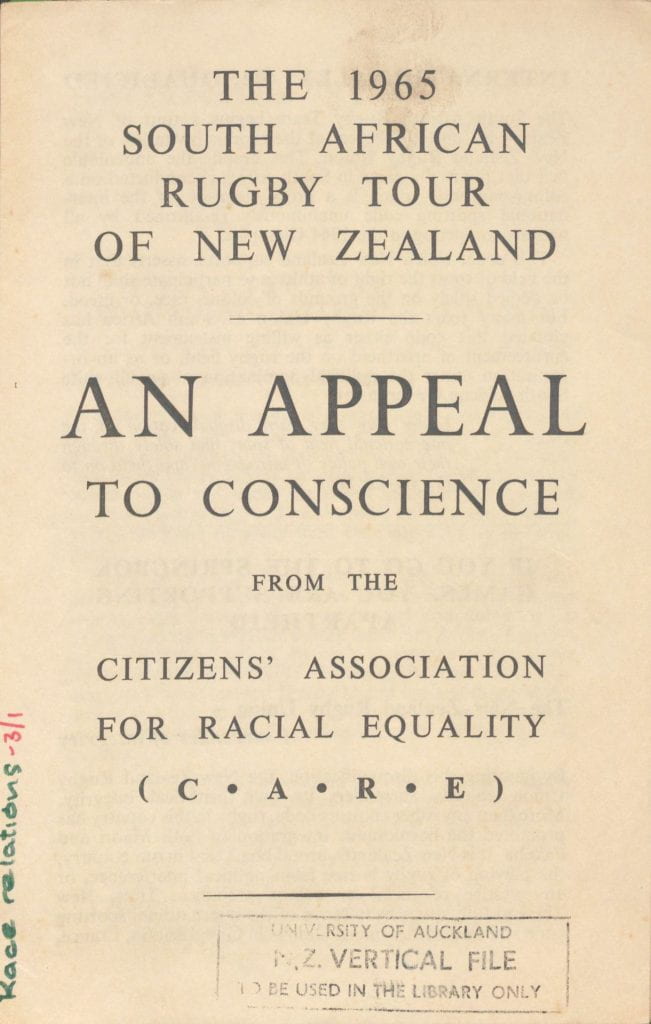
1965 CARE pamphlet, General ephemera collection, MSS & Archives 2015/23, Special Collections, University of Auckland Libraries and Learning Services.
With only three display cases to work with, however, we decided that although the 1981 tour was part of a longer history of anti-apartheid organising in New Zealand we would focus on the autumn, winter, and early spring of 1981.
With our extensive holdings relating to the University of Auckland we expected to find items that would speak to a student audience. In our university photography collection, we found a black and white print of two students, Sara Noble and Kevin Hague, in the Student Union ‘Quad’ staging a hunger strike against the tour in a ‘Bantu hut’ constructed of wood and corrugated iron. We located the photo in the New Zealand Herald which ran with the story of the protest on 29 April and included this in the display. [1]
The Springbok tour dominated the pages of the student association weekly newspaper Craccum during 1981. The Craccum issue following the final test match at Eden Park on 12 September, for instance, featured a four-page photo montage ‘Tour souvenir lift out’. [2]
However, the one time a vote was held on campus among the student body relating to the tour, in August 1981, a small majority of students (1740 to 1735) voted against a motion proposing that student association funds be allocated to pay for anti-tour activities. [3] While the tour is sometimes seen as a generational divide, the fact that a significant number of University of Auckland students opposed funding anti-tour ventures indicates it was more nuanced than this.
The centrepiece of our display is an archival item, the story of which teases out some of the complexities surrounding the tour. The General Library in February 1982 received a copy of an anti-tour ‘letter of unwelcome’ petition for depositing in the archives. It’s a hardbound copy of the petition catalogued as MSS & Archives A-241, with the snappy title ‘Letters to the people of South Africa from citizens of Auckland and citizens of Dunedin to the South African Rugby Board Museum’.
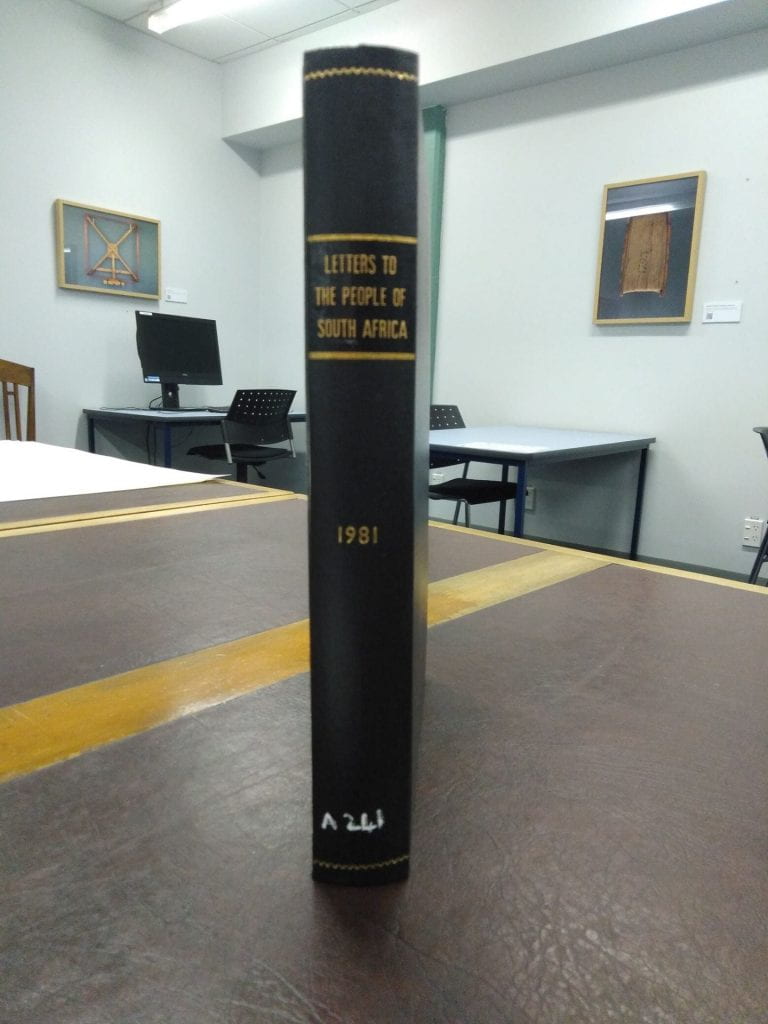
Bound copy anti-tour petition, MSS & Archives A-213, Special Collections, University of Auckland Libraries and Learning Services.
The origin of the petition was a letter of welcome to the Springbok touring party when they arrived in Invercargill for a match against Southland on Saturday 8 August. Over 1,300 Southland residents had signed the letter and Springbok tour manger, Dr Johan Claassen, promised to preserve it in the Rugby Board’s museum when he returned home to South Africa. The New Zealand Herald quoted Southland resident Carolyn Springwater, who handed over the letter to the team, as being ‘very upset’ by the way the Springbok tourists had been treated in other parts of New Zealand. [4] Here was archival evidence of New Zealanders who supported the tour but one that had (most likely) gone offshore.
Our ‘letter of unwelcome’ petition was a direct response to the Southland welcome letter. The petition was started in mid-August by Remuera mother and daughter Jenny and Rebecca Hanify, as a ‘personal protest’ against the tour. They wanted to create a lasting memento to sit alongside the Southland letter in the Rugby Board museum. In total more than 3,500 Auckland and Dunedin residents signed in one month. Two of the first signatures were the former Auckland Mayor Dove-Myer Robinson and incumbent Colin Kay. Rebecca Hanify was quoted in the Auckland Star saying that she was against apartheid, but she didn’t, ‘think it’s necessary to get involved with any of these big protest organizations and I don’t want to go out and break the law’. [5]
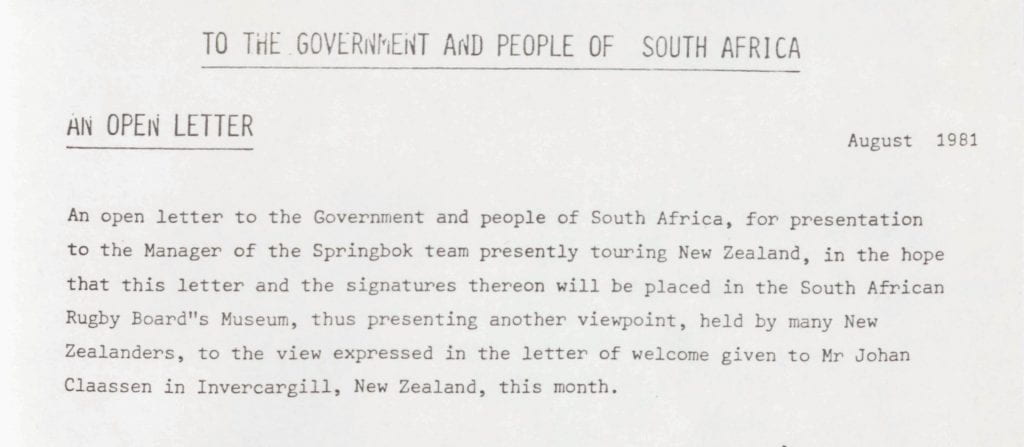
Opening text of anti-tour petition, MSS & Archives A-213, Special Collections, University of Auckland Libraries and Learning Services.
The original copy of the petition was mailed to South Africa in September 1981. A further letter in our collection from March 1982 indicates that it reached South Africa, but the South African Rugby Board refused to accept it. If the original is lost, then our copy of the petition is the only one left.
Tantalisingly, the Springbok Experience Rugby Museum in Cape Town closed in 2019, so tracking down whatever happened to both letters – welcome from Southland and unwelcome from Auckland and Dunedin – is proving difficult. We have the hope that displaying the item, writing about it on the library’s website and on this blog might trigger someone’s memory. We would also like to hear from the Hanify family so they can revisit their contribution to our collective memories of the 1981 Springbok tour.
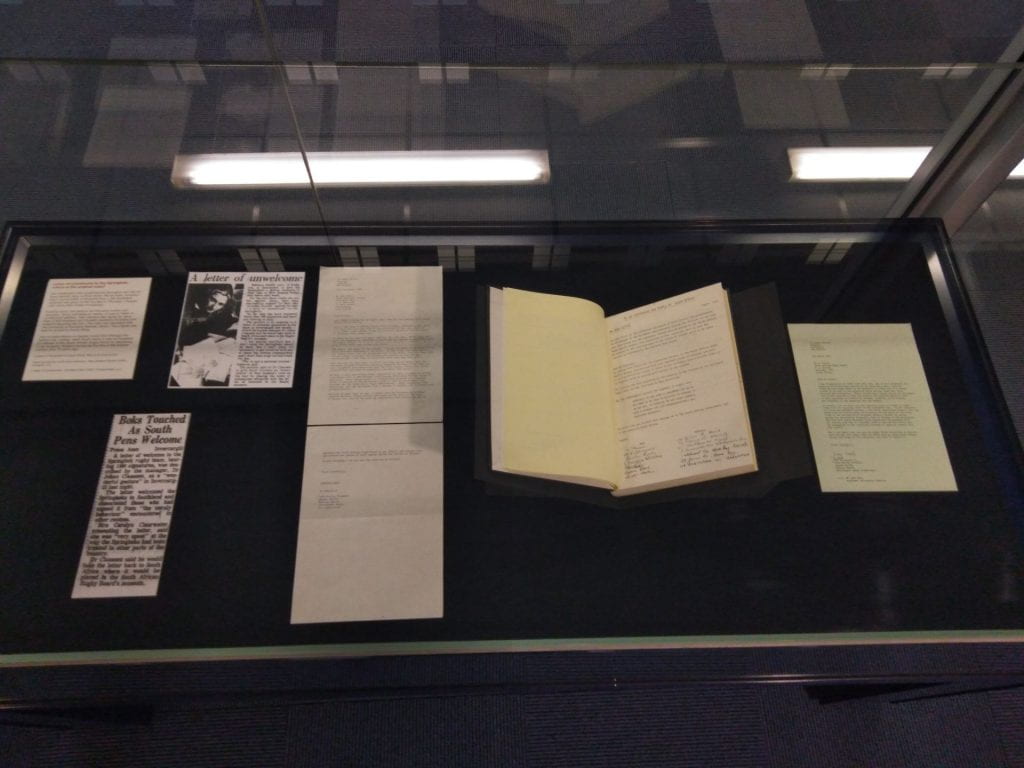
Display case featuring petition and associated items.
[1] ‘Hunger as tour protest’, New Zealand Herald, 29 April 1981, p.16.
[2] ‘Tour souvenir liftout’, Craccum, Vol. 55, No. 21, 15 September 1981, pp.11-14.
[3] ‘No one wins’, Craccum, Vol. 55, No. 20, 8 September 1981, p.4.
[4] ‘Boks touched as south pens welcome’, New Zealand Herald, 8 August 1981, p.3.
[5] ‘A letter of unwelcome’, Auckland Star, 9 September 1981, p.3

Important note about COVID Red Settings:
At Orange our libraries are open with face masks required. Vaccine passes are no longer required. Please stay home if you are unwell. Learn more about visiting our branches at Orange .
Service update:
Miramar Library will reopen at 2pm — maintenance related to last night's stormy weather is now complete. Thank you for your patience.
Service note:
Wadestown Library will close early on Thursday 12 August at 5:30pm for a community meeting.

Wellington City Libraries
Te matapihi ki te ao nui, te haerenga a ngā piringa pāka ki aotearoa i te tau 1981 the 1981 springbok tour of new zealand.

Other heritage topics
- Architecture |
- The sinking of the Wahine |
- Wellington waterfront |
- Earthquakes in Wellington |
- More heritage resources
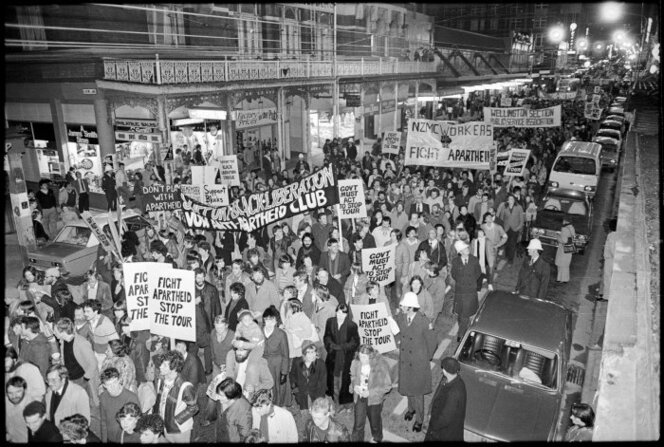
The rivalry between the Springboks and the All Blacks is one of the longest and most enduring between two sporting nations. In the past, generations of rugby players and enthusiasts from both countries viewed a series victory over the other nation as being the pinnacle of achievement in the sport. Alongside the history of fierce competition went a tradition of hospitality towards the visiting side.
In 1956 and 1965 when the South African rugby team toured New Zealand, they were showered with warmth and generosity wherever they went. Yet 25 years later, the 1981 Springbok tour became one of the most divisive events in New Zealand history.
Its impact went far beyond the rugby ground as communities and families divided and tensions spilled out onto the streets and into the living rooms of the nation. What were the events that made this tour so significant? What motivated ordinary Kiwis to take such extraordinary action against one another?
Although things had been far from perfect between my parents, the Springbok tour caused such tension and stress that we could not live together in the same house and function as a family unit. An example of the increase was when we, as a family, watched the evening news. Often one side would raise their voices in abuse and offensive name calling towards public figures. Later the abuse was turned in an indirect way on individual family members. This was done by blaming the chaos and disruption to rugby games in individual family members, their friends and associations. As the tour went on and the turmoil increased, the negative feelings intensified to such as degree that feelings of dislike, anger and incomprehension dominated our home. It's Just a Game (anon), in, The New Zealand Experience : 100 Vignettes, collected by B. Shaw & K. Broadley, 1985 .
From Digital NZ
Central library closure — collection availability.
Unfortunately much of our heritage collection is currently not available through our online catalogue — because of the closure of the Central Library, much of this collection is in storage. We hope to make it available again soon, but in the meantime, we suggest visiting the National Library of New Zealand in Thorndon (Corner Molesworth & Aitken St) to access these book titles and newspaper resources.
- Visiting the National Library
- Using the National Library Catalogue
Newspaper articles
Unfortunately, contemporary newspaper accounts of the Springbok Tour from 1981 fall into a time period where newspapers are generally not even indexed for searching, let alone available in full text online — see our finding historical Wellington newspaper articles resource.
That being said, information about (and sometimes the full text of) many anniversary accounts (10 years, 20 years later etc.), can be found online (see Online databases below) — and contemporary accounts can be accessed on microfilm if you know approximate dates (we've provided a table of key dates below).
Finding Historical Wellington Newspapers
Tip: Remember that many reports will not appear in newspapers until the following day.
Magazines — online databases
Our online databases can also be used to access a large number of articles about the tour which have previously been published in magazines . Though the databases do not go back as far as 1981, they do contain many retrospective articles written since then.
- Magazine databases
- New Zealand databases
- Newspaper databases
To access contemporary accounts of the Springbok Tour in magazines, we recommend visiting the National Library on Molesworth Street (see collection note above).
To find magazine titles of interest, have a read of the article below:
Story — Magazines and periodicals in New Zealand
Heritage Links (Local History)
The Spinoff

Ātea December 28, 2021
Three things you didn’t know about the 1981 springboks tour.

- Share Story
Summer read: This year marked the 40th anniversary of the rugby tour that divided a nation. While countless books and articles have been written about that time, some important details have faded with age. Leonie Hayden looks back at three of them.
First published July 22, 2021
Merata Mita’s documentary Patu! opens with a group collecting signatures on the street in Auckland to petition the government to stop the upcoming Springboks’ tour of New Zealand. A young passer-by starts arguing with the organisers, asking how would they feel if a group of “wogs” or “Blacks” came over here. One group member explains that she’s married to a Black South African man. Undeterred, the man continues his tirade about what would happen if “they” were in charge.
It’s 1981 and Mita’s grainy film footage captures one of those most divisive periods in our history since the New Zealand Wars. It was a battle that played out on the rugby field, in the streets, within the halls of parliament and at kitchen tables all over the country. But the fight for New Zealand to take a stand against South Africa’s apartheid regime was far from new.
The New Zealand Rugby Football Union had left rugby legend George Nēpia and other giants of the game at home in 1928 to conform with South Africa’s segregation laws. In 1959, the Citizens’ All Black Tour Association had tried to demand “No Maoris, no tour” when Māori players were excluded from the team’s 1960 visit. They weren’t successful then, but Māori players would go on to tour South Africa as “honorary whites” in 1970 and then in 1976 – the same year as the Soweto uprising that saw hundreds of children and student protestors murdered by police.
While Robert Muldoon campaigned on sports and politics being kept separate, deftly side-stepping the Commonwealth members’ Gleneagles agreement , the world had very much decided the two were connected. Black African nations boycotted the 1976 Montreal Olympics in protest of our ongoing engagement with South Africa. New Zealand was becoming a pariah.
And so when the 1981 tour was announced, anti-apartheid groups such as Halt All Racist Tours (HART), Citizens Association for Racial Equality (CARE) and the Patu Squad (led by Hone Harawira, Donna Awatere, Josie Keelan and Ripeka Evans) began a national campaign to stop it in its tracks.
Ultimately, the demonstrations and petitions to Muldoon’s government – plus a national poll showing only 46% public support for the tour – fell on deaf ears and the South African team were officially welcomed to New Zealand at Te Poho-o-Rawiri marae in Gisborne on July 19, 1981.
Tā Graham Latimer’s wero
It was a pōwhiri with teeth.
The welcome for the Springboks took place at the same time as Māori activists were spreading glass across Gisborne’s Rugby Park ahead of the first game. The speakers that evening comprised Te Poho-o-Rawiri kaumātua, dignitaries of the Tairāwhiti Māori council, and the president of the New Zealand Māori Council, the late Sir Graham Latimer .
To many the welcome would have looked like a sign of a generational divide – conservative assimilationists on the marae versus activists on the field – but Latimer ensured the pōwhiri wasn’t an occasion that ignored or played down what was at stake. In fact, he very politely told Springboks captain Wynand Claassen and his team they wouldn’t be welcome again while apartheid remained in South Africa.
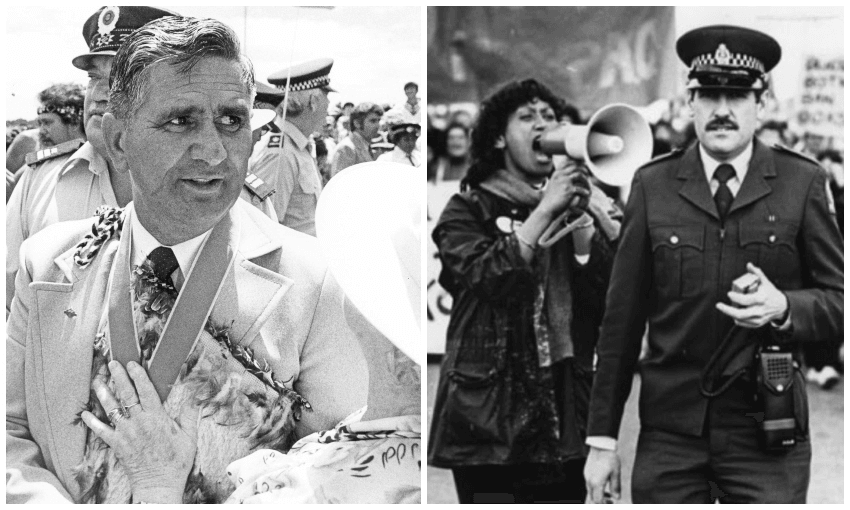
Per tradition, it was Latimer’s role as the New Zealand Māori Council president to extend a greeting to any international group being welcomed onto a marae. The speaker before him, Tom Fox, had emphasised with some pride, and to much applause, that the Tairāwhiti branch was the only Māori council that actively supported the tour.
Latimer, however, was less effusive. “I am fully conscious of the fact that I do not have a complete mandate to make this welcome,” he began. “Seven out of the nine district councils that make up the New Zealand Māori council are opposed to the tour, and one is undecided.” A long pause, silence from the crowd.
“Fifty-four per cent of the general public of New Zealand has expressed opposition to your tour. That’s in a poll. The last time such a tour was mooted, only 16% were against the tour. That you have come has been seen by some as a major victory but it must be recognised that if there were only another 6% against the tour, there would be neither a political party not a rugby union game enough to extend an invitation to you.”
He continued: “There can be no doubt in my mind that we will not be making another such welcome on a Māori marae – I emphasise that point – unless your government can show it is prepared to change its policies on apartheid. We hope we can look forward to a time in the not too distant future when you could be welcomed on any marae. It would be a pity if this could be looked upon as the last international tour by South Africa.”
Latimer finished by giving an especially warm mihi to Errol Tobias, the first player of colour to tour with the Springboks. “I believe he represents hope for 18 million South Africans, for whom there appears to be little hope.”
The genius of Latimer’s challenge was in its statesmanlike delivery. While much of his speech was received with (presumably) shocked silence, he was still rewarded with a huge round of applause at its conclusion, even though he had just told those gathered they would not be welcome in future under the same circumstances. The extraordinary recording of that evening, housed in the Ngā Taonga archive , captures a mild-mannered assassin executing an entire squad with diplomacy.
Naturally we have no way of measuring the effects of that speech on either the Springboks or apartheid. But it may have been the last time the issue was discussed politely.
Police violence was far worse than they’d like you to remember
Nicknamed the Day of Shame, July 22 saw the Springboks’ opener against Poverty Bay. Three hundred protestors marched to Rugby Park in Gisborne via a nearby golf course and attempted to breach a fence. Rugby fans jumped into action and a brawl broke out between the two groups. Police arrived to break up the fighting, and only two men managed to run onto the field. Thirteen were arrested and many were hurt in the resulting brawl, but it was nothing compared to the violence that was to come.
Over the course of the next two months, police, in particular the infamous Red and Blue riot control squads, would become more and more comfortable with using extreme violence against unarmed protestors, causing serious and sometimes permanent injuries. Pro-tour rugby fans were also brutal in their retaliation.
Singer and journalist Moana Maniapoto, then a first-year law student at the University of Auckland, remembers when the fence came down at the second game in Hamilton on July 25. “Everyone’s leaning on it, pushing and pushing it, and then the next minute the fence came down and you just heard this ‘Run!’ You’re just swept along. So then I’m in the middle thinking, ‘what am I doing here? They’re gonna kill us!'”

She recalls looking up at thousands of angry faces in the stands. “They were totally rabid. Screaming, yelling and throwing cans of beer at us.
“The police arrived, just the ordinary cops, not the Red Squad, and I actually thought, ‘oh this is good, surely they’re not gonna let us get murdered’. Then the commissioner came on and said the match has been called off and there was this huge roar from the crowd. At first it was like, ‘yay!’ and then ‘oh my god. How the hell are we gonna get out of here?’”
Maniapoto, along with land protector Eva Rickard and another friend, managed to escape into the surrounding streets. “The cops were sporadically placed so you had to make a run for it to the gate. Then the cops recognised Eva and they were abusing the shit out of her. But we got out, and we were very lucky, my friend’s father heard on the radio that the match had been cancelled and he circled until he found us. A lot of people got attacked.”
Marx Jones and Grant Cole flour bomb Eden Park in a hired Cessna.
She would go on to attend protests in Rotorua and at the third test in Auckland – the latter resulting in a violent clash between police, protestors and rugby fans on the streets of Mount Eden. “Red Squad came out of nowhere and nutted off at everyone. I was with the least militant bunch when they charged. We were just standing there. Couldn’t believe it. I was batoned, kicked by heavy police boots while on the ground. Shock for a young freshie like me. They just smashed into us and left people lying on the ground in their wake.”
For further proof you need only watch the violence through Mita’s lens. The dull thud of police batons hitting flesh and human skull, and the wails of the injured, some of them young teenagers, is the haunting soundtrack for nearly half the film.
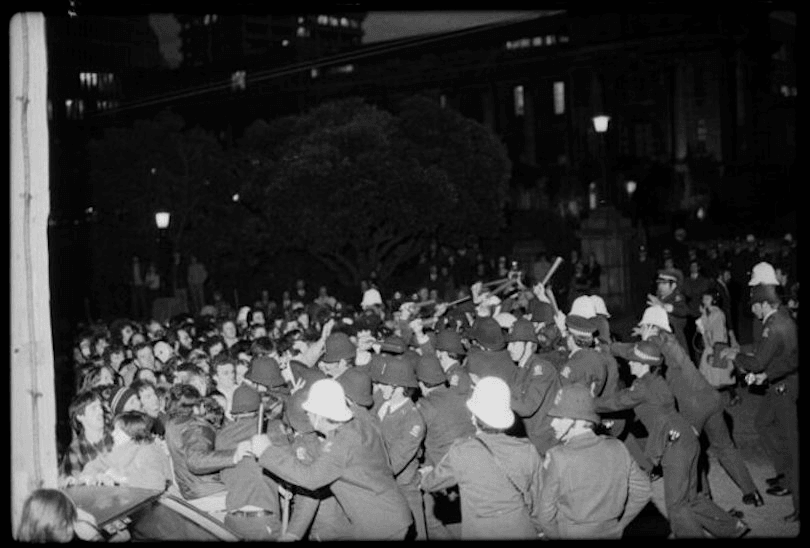
Maniapoto scoffs at the selective memory that it was “New Zealand” who took a stand against apartheid. “It’s held out as a landmark, framing New Zealand as a global social justice advocate. It wasn’t New Zealand; it was people power. It was activists, people from across all walks of life, and there were far fewer of us than there were in the stands.”
She talks abut the Nelson Mandela exhibition hosted at Eden Park in 2019 – a strange venue considering the violence that played out on the surrounding streets 38 years earlier. She says at the launch none of the speakers from the New Zealand Rugby Union came close to admitting they’d been wrong, or offering an apology. Instead everybody spoke proudly about the stand taken by the protestors. Says Maniapoto: “They’re starting to rewrite the history!”
The good bishop saves the Patu Squad
It was at the last test at Eden Park on September 12 that a young Hone Harawira, one of the leaders of the predominantly Māori and Pasifika Patu Squad, was finally caught.
Harawira and a handful of others had been arrested at Waitangi earlier in the year, and although they had been denied bail, they were turfed out of the cells for causing a ruckus and told when to attend their court date. They didn’t show up.
The group had outstanding warrants for their arrest before the tour even began.
“It must have got out to the police that we were all going to be involved in the tour, and one by one we were all picked up. One of the brothers, they got him before it started! So he spent the whole of the tour in Mt Eden,” Harawira chuckles.
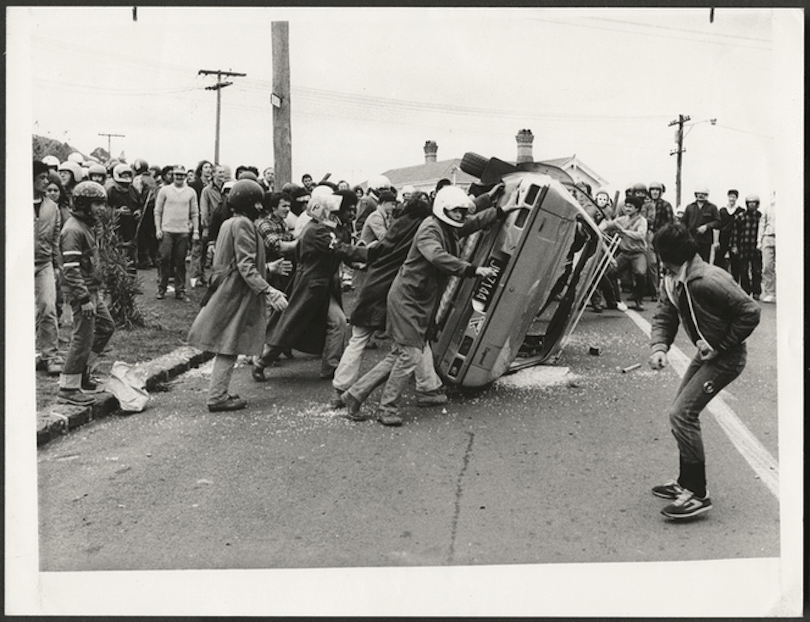
Harawira says he was caught early on after the test that ended with Marx Jones’ aerial flour bomb attack , so hadn’t been involved in the upturning of a cop car, or the violence that erupted on an unprecedented scale outside Eden Park. Nevertheless, Harawira was charged with the assault of a police officer who’d had both collar bones broken.
“It wasn’t me but they wanted someone to pin it on so they pinned it on me.”
He says he had seven charges against him. “They were serious charges. Three charges of participating in a riot and four charges of assault with intent to cause grievous bodily harm. Which all carried a total of something like 98 years.”
Justice being neither blind nor in a hurry, Harawira wouldn’t stand trial for another two years, alongside many others who he notes were mostly brown, despite the vast majority of protestors being Pākehā. “Most of them were members of the Patu Squad.”
As he had many times before, Harawira planned to defend himself in court. He’d had University of Auckland law lecturers Jane Kelsey and David Williams to rely on for advice, but this time he wasn’t sure it going to be enough.

“The day before my court date, I’m sitting out the back in the cells thinking ‘jeez, what am I gonna do?’ Then the brain wave came to me. Bishop Desmond Tutu had been invited over by the Anglican church to come and do a speaking tour. Interest was still very high in apartheid South Africa. My mum knew George and Jocelyn Armstrong, who were part of the organisation that brought him over.
“So I rang my mum and said look, I want Bishop Tutu as a witness. She said, ‘He wasn’t there!’. I said, ‘that doesn’t matter! I want him for my witness’. So she said ‘OK when is it?’ And I said ‘Tomorrow! I’m gonna need him by about 10.30.’”
The next day Harawira and 10 others prepared to stand trial.
When the time came for him to give his defence, his star witness wasn’t there. “I read my statement. I’d come to the very end and I was dragging it out. I didn’t want to get out of the dock ‘cos I knew it hadn’t been enough to get me off. Then the door burst open, and someone looked at me with a big smile and just nodded and I knew then. So I asked the judge: ‘Can you please call my witness?’”
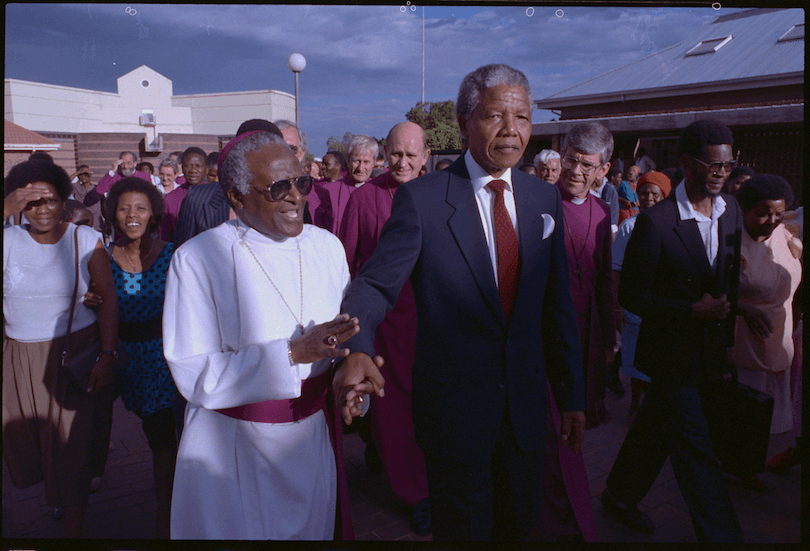
Harawira still laughs at the memory of the stunned faces of the judge, prosecution and jury as as the now-Archbishop Desmond Tutu, in his signature dark suit and purple cleric’s shirt, walked into the courtroom.
“And then I’m thinking, ‘What the fuck, now what do I do?’
“So he takes the stand and I go, ‘Could you please tell the court your name?’ And then I said, ‘Can you please tell the court your address?’ And he gave an address in Soweto. Instantly, if the room wasn’t already charged, everyone was completely wide-eyed now.
“And then I said, ‘Can you please explain to the court what apartheid is?’. And away he went. He must have spoken for 20 minutes. It was absolutely stunning. You could have heard a pin drop.”
He says that after Tutu had finished, neither he nor the prosecution could think of any more questions.
“As Bishop Tutu stepped out of the dock, all 11 defendants, we all stood up. Then our lawyers stood up, then the public, the screws from Mount Eden, the police stood up, then the jury stood up. Half of them were in tears. If was one of those moments. I knew right then and there we were gonna get off.” He crows in delight at the memory.
The group were acquitted of all charges.
“It’s kind of hard to believe but it’s all true. Meeting Nelson Mandela himself and going to his tangi, that’s another story.”
We are here thanks to you. The Spinoff’s journalism is funded by its members – click here to learn more about how you can support us from as little as $1.
Weekend Rewind: The 1981 Springbok Tour, 35 years on
Share this article
Anti Springbok tour protesters at Auckland International Airport protesting the arrival of the South African rugby team in 1981. Photo / File, NZ Herald Archive
On July 19 1981, the South African rugby team arrived in New Zealand, dividing the nation, and sparking 56 days of major civil unrest (along with years of subsequent fallout.) More than 200 demonstrations took place throughout the country, with over 150,000 people taking part. Clashes between tour supporters and protesters, and protesters and police, became increasingly frequent and violent. Not surprisingly, many of our film and television makers felt it important to document and interpret events.
Directed by Merata Mita, Patu! Is both a landmark in New Zealand's film history and a startling record of the tour. Made on a shoestring budget, with the aid of several volunteer camera people (among them Roger Donaldson), it still holds up as a standout piece of activist filmmaking. The documentary profiles the anti-tour campaign, capturing highly charged footage of the clashes. While filming, stock was shifted around and, at times taken out of, the country, as the production team went into hiding to prevent the police from hijacking the editing process.
Watch Patu! here:
Made for the 25th anniversary of the tour in 2006, the documentary Try Revolution examines the impact of the tour in South Africa, showing how events in New Zealand poured shame on the apartheid regime, and helped provoke democratic change. As quoted from Archbishop Desmond Tutu: "You really can't even compute its value, it said the world has not forgotten us, we are not alone."
Watch an excerpt from Try Revolution here:
Landmark documentary series Revolution mapped the social and economic changes in 1980s New Zealand. Touching on the political ramifications of the tour, it highlights then Prime Minister Robert Muldoon's refusal to intervene in its go-ahead, and the effects of his decision on the National Party. Writer CK Stead reflects on the tension of the on-field protest that stopped the tour's Hamilton game.
See part two of Revolution for coverage of the tour:
1982 one-off drama The Protesters explores issues surrounding race and land ownership in the aftermath of both the tour and the occupation of Bastion Point. Starring Billy T James, Jim Moriarty and Merata Mita, it also features early roles from Robert Rakete and former newsreader Joanna Paul. Capturing a mood of division and uncertainty, it's a telling representation of the post-tour climate.
Watch The Protesters here:

Made in 2011, TV movie Rage is set during the tour, telling the story of a protester who falls in love with an undercover policewoman. The script was written by noted cartoonist and columnist Tom Scott - a protester during the tour - and his brother-in-law Grant O'Fee, a detective sergeant in Wellington at the time.
Watch an excerpt from Rage here:
Made by Ric Salizzo and John Kirwan in 1992, All Blacks for Africa - A Black and White Issue follows the All Blacks on their first post-apartheid visit to South Africa. Between scenery shots and match highlights, players past and present reflect on politics and sport - amongst them ex-AB Ken Gray, who refused to tour the republic in 1970 and joined anti-tour protesters in 1981.
Watch All Blacks for Africa - A Black and White Issue here:
You can see more Springbok Tour footage here, in NZ On Screen's Spotlight Collection.

Latest from Entertainment

Wife of rumoured new James Bond speaks out over their 24-year age gap
Director says after 14 years together, the public's interest has 'gone away a little bit'.

David Beckham sues huge Hollywood star for $17.8m

Victoria Beckham carried out of $525K birthday bash

Britney Spears in talks for biopic based on her book

How smart charging saves money, power
The 1981 Springbok rugby tour
Coverage of the game and the protest actions
Collection items
The vault - 1981 springbok rugby tour.
Flour bombs, flares and leaflets were dropped from a low flying Cessna plane which buzzed the third and final game of the 1981 Springbok Tour - dramatic Radio New Zealand coverage of the game and the… Audio
- Download as Ogg
- Download as MP3
- Play Ogg in browser
- Play MP3 in browser
Access All Areas: A Country Divided
The winter of 1981 saw the Springboks rugby team tour New Zealand, and Kiwis divided. Recent Maori attempts to reclaim ownership of government requisitioned land at Bastion Point had focused attention… Audio
This audio is not downloadable due to copyright restrictions.
Anti-tour protestor reflects on thirty years since first game
Thirty years since the first game in the 1981 Springbok rugby tour of New Zealand. Audio
Brian Morris remembers the 1981 Springbok Tour
Ngāti Kahungunu Rongowhakaata Brian Morris was a Hawkes-Bay-representative-rugby-playing-school-teacher in 1981 when he made a stand against apartheid and the Springbok tour. He talks about that… Audio
Tom Scott: Rage
Tom Scott is a cartoonist, satirist, author and playwright. His latest project is a television docu-drama centred on the controversial 1981 Sprinkbok tour of New Zealand. Rage is the story of two… Audio
Springbok Tour put NZ Commonwealth Games in danger
Confidential Australian cabinet papers from 30 years ago, which have just been made public, reveal that concern about the 1981 Springbok tour was so high, it jeopardised New Zealand's participation at… Audio
New Zealand As It Might Have Been: Bob Gregory
What would have happened if New Zealand had lost the last test against the Springboks during the troubled tour of 1981? Bob Gregory, a professor of politics at Victoria University of Wellington… Audio
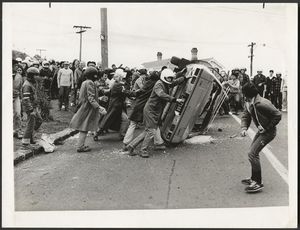
External Links
- The tour on NZ History Online
- The 1981 Springbok tour at Te Papa
- Patu! : Merata Mita’s documentary about the winter of 1981 on NZ On Screen

IMAGES
COMMENTS
Police officers guarding a barbed wire perimeter around Eden Park near Kingsland railway station.. The 1981 South African rugby tour (known in New Zealand as the Springbok Tour, and in South Africa as the Rebel Tour) polarised opinions and inspired widespread protests across New Zealand.The controversy also extended to the United States, where the South African rugby team continued their tour ...
1981 Springbok tour Page 1 - Introduction. ... 1982 Football World Cup. Homosexual law reform. New Zealand cricket. The 1951 waterfront dispute. Nuclear-free New Zealand. Sport, 1940-1960. Responding to tragedy. The 1912 Waihi strike. South African 'Boer' War. Natives' Rugby Tour, 1888-89.
1981 Springbok tour Page 7 - Tour diary ... 1982 Football World Cup. Homosexual law reform. New Zealand cricket. The 1951 waterfront dispute. Nuclear-free New Zealand. 1981 Springbok tour. Sport, 1940-1960. Responding to tragedy. The 1912 Waihi strike. Natives' Rugby Tour, 1888-89.
The Springbok Tour. The springbok tour of the 1980's was the largest civil disturbance New Zealand had seen in thirty years. The whole of New Zealand was divided over the tour, this division of the country lasted over fifty days. The Springbok tour was a real factor in the way New Zealand grew as a county. The outcomes that arose from the ...
Support for the Springbok tour was particularly strong in rural and small-town New Zealand. In the Taranaki dairy town of Eltham, 50 protesters were showered with eggs and bottles as they marched up the street one Friday night. In the 1981 general election National retained power because it held on to marginal provincial seats such as Gisborne ...
The Springbok rugby tour brought us to the brink of civil war, as many protested the racial segregation of Apartheid South Africa and made links to racism at home. On the 29th of July, 1981, protesters opposing the Springbok Tour were met by baton-wielding police trying to stop them marching up Molesworth St to the home of South Africa's ...
For the 40th anniversary of the 1981 Springbok Tour, we talked to two Wellington residents who remember those turbulent times. During the winter of 1981, violent clashes between rugby supporters, protesters and the police erupted all over Aotearoa in one of our country's most tumultuous periods. The Springbok rugby tour was a tumultuous time for the nation with many protesting the racial ...
July 22 - 1981 Springboks tour first match. South Africa 24 vs Poverty Bay 6. Because of the very strong feelings about South Africa's apartheid policy the 1981 Springbok tour of New Zealand was always going to bring protests and controversy. No one knew just how the protests would play out. The first tour match, in Gisborne, remote from the ...
The Springbok Tour - 35 Years On. Tuesday 19 July marks the 35th anniversary of the Springboks' arrival in New Zealand for the 1981 rugby tour. Collected below are classic documentaries on the tour and subsequent mass protests (Patu!, Try Revolution), anti-tour protest songs, and a doco on the All Blacks' first post-apartheid tour of South ...
From 22 July - 12 September 1981 the South African Rugby Union team (known as the Springboks) toured New Zealand playing 14 games. Due to the South African governments policy of apartheid, the tour was marred by protests and police violence. The All Blacks and the Springboks had been fierce rivals since their first face-off at Athletic Park ...
The narrative of the 1981 Springbok tour continues to reflect New Zealand's anti-apartheid views, but in fact protestors treated it more as a critique of New Zealand Society, research shows. Dr Sebastian Potgieter, School of Physical Education, Sport and Exercise Sciences.
and the 1981 Springbok Rugby Tour HaMISH MCdOuGall† london School of economics and Political Science The 1981 South Africa rugby tour of New Zealand brought widespread protest and global attention. It should be understood in an international context. Both anti-tour protestors and the New Zealand government viewed international
A country divided — 1981 Springbok Tour. For 56 days in July to September 1981, New Zealanders were divided against each other because of the Springbok rugby tour. Explore our online exhibition of photos and cartoons about the 1981 Springbok tour from the Alexander Turnbull Library collections.
The Springbok tour dominated the pages of the student association weekly newspaper Craccum during 1981. The Craccum issue following the final test match at Eden Park on 12 September, for instance, featured a four-page photo montage 'Tour souvenir lift out'.[2] However, the one time a vote was held on campus among the student body relating ...
The controversial 1981 Springbok tour, which divided NZ, began 30 years today. Relive the memories. Image 1 of 14: New Zealand Prime Minister Sir Robert Muldoon commenting on the forthcoming tour ...
Tension around the country grew as the Springbok Tour made its way around New Zealand. Here's a look back at one of the most controversial sporting tours eve...
Newspaper articles. Unfortunately, contemporary newspaper accounts of the Springbok Tour from 1981 fall into a time period where newspapers are generally not even indexed for searching, let alone available in full text online — see our finding historical Wellington newspaper articles resource.. That being said, information about (and sometimes the full text of) many anniversary accounts (10 ...
The 1981 Springbok tour schedule (map) Step through to find out what happened at different games when the Springboks visited in 1981. This was a tour of New Zealand's provincial heartland - to the homes of grassroots rugby - but the 1981 Springbok tour, which began in Gisborne on 22 July, pitched New Zealanders against each other.
NZ Sporting History: The 1981 Springbok Tour. New Zealand continued to play rugby against South Africa through the years of apartheid, and toured over there with a 'white only team'. Then in 1981 the Springbok team were welcomed onto our shores. Audio.
Nicknamed the Day of Shame, July 22 saw the Springboks' opener against Poverty Bay. Three hundred protestors marched to Rugby Park in Gisborne via a nearby golf course and attempted to breach a ...
Next week marks the 35th anniversary of 1981's Springbok Tour of New Zealand. NZ On Screen's Nicky Harrop revisits classic film and television depictions of one of the most turbulent chapters in ...
Springbok Tour put NZ Commonwealth Games in danger. 13 Jun 2012. Confidential Australian cabinet papers from 30 years ago, which have just been made public, reveal that concern about the 1981 Springbok tour was so high, it jeopardised New Zealand's participation at…. Audio.
In 1980, New Zealand again attempted to bring the Springboks to New Zealand. The Springboks arrived on July 19, 1981. Though they were officially welcomed by the New Zealand government, there was a sense of dread and anticipation that surrounded their arrival - perhaps, some thought, the 1981 tour should have been cancelled like the tour in ...